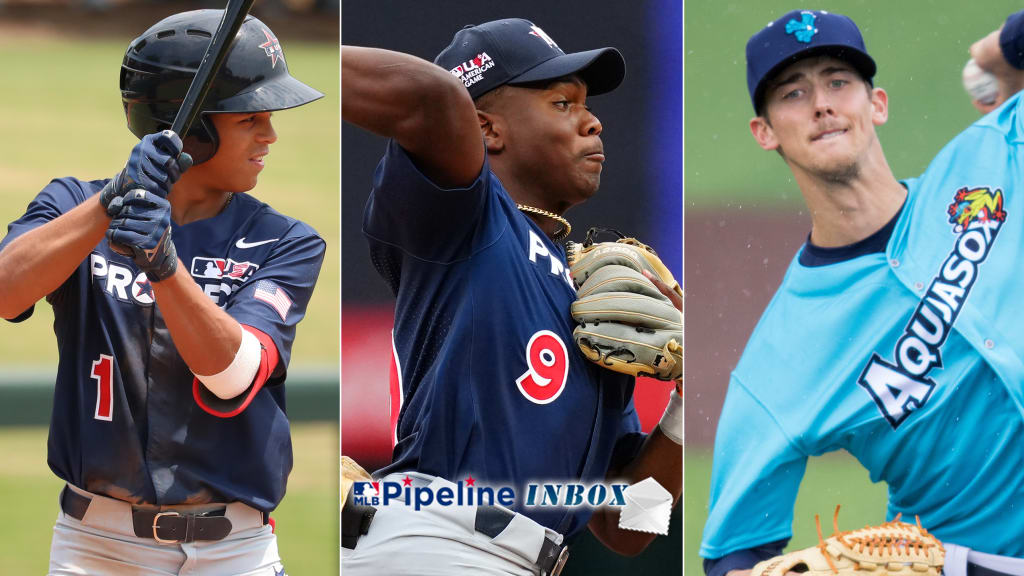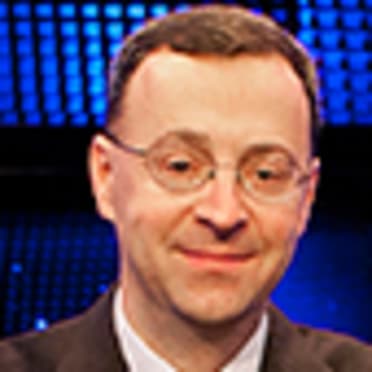
This year has just begun and we're already thinking about next year's Draft. Greg Amsinger, Harold Reynolds, Jonathan Mayo and I recorded a one-hour MLB Network special on the 2023 Prospect Development Pipeline League, which will be held June 29 through July 5 at the USA Baseball National Training Complex in Cary, N.C.
We spotlighted 25 high school players who already have received invites to the PDP League, and we were joined by two of them as well as former All-Star Michael Cuddyer, who was USA Baseball's hitting coordinator at last year's event as well as an assistant coach on the U.S. 2021 national 18-and-under team. The hour-long program will broadcast for the first time at 6 p.m. ET on Saturday and re-air several times that weekend and the next.
And speaking of the Draft, this year's group is the subject of the bulk of this edition of the Pipeline Inbox ...
How do the 2022 top prep players [Druw Jones, Termarr Johnson and Elijah Green] compare to recent prep players like [Bobby Witt Jr.], [Marcelo] Mayer and [Jordan] Lawlar? --@jopo12191
High schoolers occupy the top three spots on MLB Pipeline's 2022 Draft Top 100, with outfielder Druw Jones at No. 1 followed by middle infielder Termarr Johnson and outfielder Elijah Green. Let's take the three best prep position players from each of the previous three years and line them up based on their ability heading into the Draft:
- Bobby Witt Jr., SS (2019)
- Druw Jones, OF (2022)
- Termarr Johnson, 2B (2022)
- Marcelo Mayer, SS (2021)
- C.J. Abrams, SS (2019)
- Riley Greene, OF (2019)
- Jordan Lawlar, SS (2021)
- Elijah Green, OF (2022)
- Kahlil Watson, SS (2021)
- Zac Veen, OF (2020)
- Robert Hassell, OF (2020)
- Ed Howard, SS (2020)
Witt was an easy choice for the top spot. Since the single-Draft era began in 1987, the only better shortstop prospect was Alex Rodriguez, and A-Rod is the best overall prospect in the entire history of the Draft.
As you can see by those rankings, this year's trio is quite exciting. Jones is very reminiscent of his father, five-time All-Star and 10-time Gold Glover Andruw, while Johnson is the best pure high school hitter I can remember. Green may have a higher offensive ceiling than either of them, though he comes with some swing-and-miss concerns and less defensive value.
Of the top 10 picks in the upcoming draft, how many do you expect will be hitters? --@RoxDontRake
As mentioned above, there's an impressive group of high school bats who will go at or near the top of the Draft in July. The college position player crop is loaded as well, led by Cal Poly shortstop Brooks Lee, Texas Tech second baseman Jace Jung, Stanford outfielder Brock Jones and James Madison outfielder Chase DeLauter.
My best guess is that at least eight hitters will go in the first 10 selections. Dylan Lesko is a gifted high school right-hander who belongs in that territory, even if he comes from a risky Draft demographic. While the college pitching pool is very murky right now, a right-hander such as Peyton Pallette (Arkansas), Blade Tidwell (Tennessee) or Landon Sims (Mississippi State) will push his way into the top 10.
How far off from the Top 100 are Mariners pitching prospects Matt Brash and Brandon Williamson? --@alexledbetter15
We've begun work on updating our Top 100 Prospects list for 2022 and both Brash and Williamson are receiving strong consideration.
Brash was stolen from the Padres in September 2020 as the player to be named for Taylor Williams, whom San Diego waived 12 months later. Brash posted loud numbers last season (2.31 ERA, .180 opponent average, 142 strikeouts in 97 1/3 innings between High-A and Double-A) and elicits strong opinions from evaluators.
Some suggest that Brash might have the best slider in the Minors and others worry that he comes with a lot of reliever risk. The right-hander also owns a mid-90s fastball and whether he remains a starter will depend on his ability to improve his strike-throwing.
A 2019 second-round pick from Texas Christian, Williamson may be the most underappreciated left-hander in the Minors. He possesses a pair of plus pitches in his fastball and curveball, backs them up with an effective slider and changeup and fills the strike zone. Pitching at the same levels as Brash, he logged a 3.39 ERA with a .227 average and 153/33 K/BB ratio in 98 1/3 innings.
Draft pick trading has been a topic of discussion at recent Drafts. With the Mets having two first-round picks, currently 11 and 14, but it's starting to look like the 11th pick will be dropped ten spots. Hypothetically, how high could their picks bring them? --@McLovinOC8
Using 2021 valuations, the No. 11 choice was worth $4,547,500 and No. 14 was worth $4,036,800 in terms of bonus-pool money. That total of $8,584,300 exceeded the $8,415,300 slot value for the No. 1 pick. But this isn't just an exercise in math.
History tells us that the picks at the very top of the Draft are much more valuable than mid-first-rounders, and the Mets would have to pay a premium for moving up. My gut feel is that in a typical Draft, the 11th and 14th selections would be equal to the third pick in terms of talent. But that would change from year to year based on the players available.
Let's look at last year's Draft. The Tigers loved Jackson Jobe at No. 3, and I don't believe they would have traded that choice for Nos. 11 and 14, even if it would have landed them an additional $1.36 million in bonus-pool money. Because many clubs are skittish about high school right-handers, Detroit possibly could have finessed Jobe all the way down to No. 11 with a well over-slot bonus, so maybe that could have gotten interesting.?
The Red Sox landed MLB Pipeline's top-rated prospect (Marcelo Mayer) at No. 4, so I couldn't see them dealing down either. But the Orioles took a discount on Colton Cowser at No. 5 to shift bonus-pool money to later choices, so they almost certainly would have been willing to swap for Nos. 11 and 14 to pick up an extra $2.4 million in Draft cash -- and would have had a good shot at getting Cowser at No. 11. But would the Mets really sacrifice that much in spending power just to jump up to No. 5 unless Baltimore threw in, say, a third-rounder?
Finding an equitable trade that would satisfy both sides seems like it would be hard to pull off. But it's a fascinating question.
